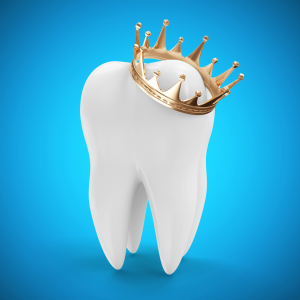
When your dentist says “you’ll probably need a crown” after examining a troublesome tooth, what exactly are they talking about and why do you need to be “crowned.” Crowns are a type of dental restoration that involves putting a protecting covering (a crown) over a tooth. There is a wide range of materials that the crown can be made from, ranging from porcelain to metals.
So what types of oral health issues call for a crown?
Damage to a tooth is so severe that it cannot be fixed by placing an amalgam or composite restoration (a filling).
The appearance of the tooth is less than desirable and the placement of a crown can improve the shape, color and in some cases the alignment of the tooth.
To protect a weak tooth due to decay.
To protect a weak tooth that has been cracked.
To hold a dental bridge into place.
To cover a dental implant.
How is a crown placed on the existing tooth?
After a careful exam, your dentist will evaluate your needs and then review your options for repairing or replacing the tooth. If a crown is the best approach for your situation, your dentist at Dental South will initially “prep” the troublesome tooth. This involves removing any decay and readying the tooth for the permanent crown. This may include fabricating a build-up if there is not enough healthy tooth surface left to hold and stabilize the new crown.
An impression is taken and a “temporary” crown is fabricated after the tooth is “prepped”. The temporary crown is seated while the permanent crown is being made in the lab. Once the crown is finished, typically 1 to 2 weeks, the patient will return to get the permanent crown cemented into place.
So what are the different types of materials used in crowns?
Stainless steel crowns are prefabricated crowns that are used on permanent teeth primarily as a temporary measure. The crown protects the tooth or filling while a permanent crown is made from another material. They are often used with children’s primary teeth. The crown covers the entire tooth and protects it from further decay. When the primary tooth comes out to make room for the permanent tooth, the crown comes out naturally with it.
Metals used in crowns include gold alloy, palladium, nickel or chromium. Compared with other crown types, less tooth structure needs to be removed with metal crowns, and tooth wear to opposing teeth is kept to a minimum. Metal crowns withstand biting and chewing forces well and probably last the longest in terms of wear down. Also, metal crowns rarely chip or break. The metallic color is the main drawback. Metal crowns are a good choice for out-of-sight molars.
Porcelain-fused-to-metal dental crowns can be color matched to your adjacent teeth (unlike the metallic crowns). However, more wearing to the opposing teeth occurs with this crown type compared with metal or resin crowns. The crown’s porcelain portion can also chip or break off. Next to all-ceramic crowns, porcelain-fused-to-metal crowns look most like normal teeth. These crowns can be a good choice for front or back teeth.
All-resin dental crowns are less expensive than other crown types. However, they wear down over time and are more prone to fractures than porcelain-fused-to-metal crowns.
All-ceramic or all-porcelain dental crowns provide better natural color match than any other crown type and may be more suitable for people with metal allergies. However, they are not as strong as porcelain-fused-to-metal crowns and they wear down opposing teeth a little more than metal or resin crowns. All-ceramic crowns are a good choice for front teeth.
SOURCE: WebMD and American Dental Association
